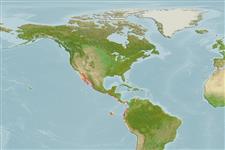Classification / Names
Common names from other countries
Main reference
Size / Weight / Age
Max length : 65.0 cm TL male/unsexed; (Ref. 2850); common length : 25.0 cm TL male/unsexed; (Ref. 55763)
Environment
Marine; reef-associated; depth range 3 - 50 m (Ref. 37955)
Climate / Range
Subtropical, preferred ?; 33°N - 15°S, 118°W - 76°W
Distribution
Short description
Body very deep and compressed; head short, with a slopping, slightly concave profile; mouth small and terminal; snout blunt and not at all prominent; posterior end of jaw not surpassing anterior rim of eye; branchiostegal membranes joined to isthmus; dorsal fin spines well developed (Ref. 55763).
IUCN Red List Status (Ref. 115185)
Threat to humans
Harmless
Human uses
Aquarium: commercial
More information
Common namesSynonymsMetabolismPredatorsEcotoxicologyReproductionMaturitySpawningFecundityEggsEgg development
ReferencesAquacultureAquaculture profileStrainsGeneticsAllele frequenciesHeritabilityDiseasesProcessingMass conversion
Tools
Special reports
Download XML
Internet sources
Estimates of some properties based on models
Phylogenetic diversity index
PD50 = 0.6250 many relatives (e.g. carps) 0.5 - 2.0 few relatives (e.g. lungfishes)
Trophic Level
3.3 ±0.43 se; Based on food items.
Resilience
Medium, minimum population doubling time 1.4 - 4.4 years (Preliminary K or Fecundity.)
Vulnerability
Moderate vulnerability (45 of 100)
Price category
